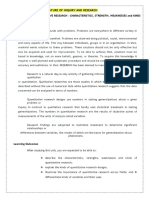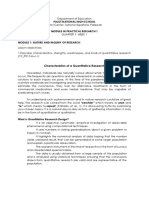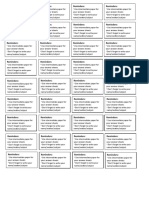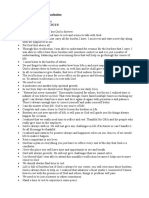Unit 1: Nature of Inquiry and Research: What This Unit All About?
Unit 1: Nature of Inquiry and Research: What This Unit All About?
Uploaded by
Richard Tampog GaleraCopyright:
Available Formats
Unit 1: Nature of Inquiry and Research: What This Unit All About?
Unit 1: Nature of Inquiry and Research: What This Unit All About?
Uploaded by
Richard Tampog GaleraOriginal Description:
Original Title
Copyright
Available Formats
Share this document
Did you find this document useful?
Is this content inappropriate?
Copyright:
Available Formats
Unit 1: Nature of Inquiry and Research: What This Unit All About?
Unit 1: Nature of Inquiry and Research: What This Unit All About?
Uploaded by
Richard Tampog GaleraCopyright:
Available Formats
UNIT 1: NATURE OF INQUIRY AND RESEARCH
WHAT THIS UNIT ALL ABOUT?
Human history abounds with problems. Problems are everywhere in different variety in different
perspective which affect mankind. Problems are observed along political, social, environmental and many
aspects of life. This may between individuals, groups or in an organization. In that, mankind wants solution
to these problems. These solutions should not be only effective but also be acquired and used for
improvement. To be able to achieve that, solutions must be based in knowledge, not on mere beliefs,
guesses, or theories. To acquire this knowledge it requires a well-planned and systematic procedure and
should be continuously evaluated on its accuracy and usefulness. In that, RESEARCH has been devised to
meet this need.
Research is a natural day-to-day activity of gathering information. It may in the form of qualitative
or quantitative. Qualitative researches are those studies in which the data concerned can be described
without the use of numerical data while quantitative research suggests that the data concerned can be
analyzed in terms of numbers.
Quantitative research designs use numbers in stating generalizations about a given problem or
inquiry in contrast to qualitative research that hardly uses statistical treatment in stating generalizations.
The numbers in quantitative research are the results of objective scales of measurements of the units of
analysis called variables.
Research findings are subjected to statistical treatment to determine significant relationships or
differences between variables, the results of which are the bases for generalization about phenomena.
In this unit, you will be encountering also the characteristics of quantitative research, its strength
and weaknesses, its kinds and importance across disciplines. In here also, we will be tackling kinds of
variables and its uses.
DEFINITION OF QUANTITATIVE RESEARCH
Quantitative research is an objective, systematic empirical investigation of observable
phenomena through the use of computational techniques. It highlights numerical analysis of data
hoping that the numbers yield unbiased results that can be generalized to some larger population
and explain a particular observation. Simply, quantitative research is concerned with numbers and
its relationship with events.
The quantitative research suggests that the data concerned can be analyzed in terms
of numbers. An example that we can give for this study is a study comparing the performance of
Grade 12 in Upper Tumapoc National High School and Burgos National high School in Physical
Science when ICT is integrated in teaching. This can be approached by getting the average
performance of both schools before and after integrating ICT. Then the averages can be compared
and analyzed to see the differences or effectiveness. In this case, numbers are used as data for
analysis. Another is surveying what do viewers in Burgos, La Union prefer to watch: is it GMA
dramarama or ABS-CBN Golden Kapamilya noontime show. In here, it may be approached by
making a survey questionnaire asking for the preference of viewers in Burgos, La Union.
CHARACTERISTICS OF QUANTITATIVE RESEARCH
1. OBJECTIVE. Quantitative research seeks accurate measurement and analysis of target
concepts. It is not based on mere intuition and guesses. Data are gathered before proposing
a conclusion or solution to a problem.
2. CLEARLY DEFINED RESEARCH QUESTIONS. The researchers know in advance
what they are looking for. The research questions are well-defined for which objective
answers are sought. All aspects of the study are carefully designed before data are gathered.
3. STRUCTURED RESEARCH INSTRUMENTS. Standardized instruments guide data
collection, thus, ensuring the accuracy, reliability and validity of data. Data are normally
gathered using structured research tools such as questionnaires to collect measurable
characteristics of the population like age, socio-economic status, number of children, among
others.
4. NUMERICAL DATA. Figures, tables or graphs showcase summarized data collection in
order to show trends, relationships or differences among variables. In sum, the charts and
tables allow you to see the evidence collected.
5. LARGE SAMPLE SIZES. To arrive at a more reliable data analysis, a normal population
distribution curve is preferred. This requires a large sample size, depending on how the
characteristics of the population vary. Random sampling is recommended in determining the
sample size to avoid researcher’s bias in interpreting the results.
6. REPLICATION. Quantitative methods can be repeated to verify findings in another setting,
thus strengthen and reinforcing validity of findings eliminating the possibility of spurious
conclusions.
7. FUTURE OUTCOMES. By using complex mathematical calculations and with the aid of
computers, if-then scenarios may be formulated thus predicting future results. Quantitative
research puts emphasis on proof, rather than discovery.
STRENGHTS and WEAKNESSES OF QUANTITATIVE RESEARCH
STRENGHTS OF QUANTITATIVE RESEARCH
The advantages of quantitative research includes the following:
1. It is objective. The most reliable and valid way of concluding results, giving way to a
new hypothesis or to disproving it. Because of bigger number of the sample of a
population, the results or generalizations are more reliable and valid. Since it provides
numerical data, it can’t be easily misinterpreted.
2. The use of statistical techniques facilitates sophisticated analyses and allows you to
comprehend a huge amount of vital characteristics of data.
3. It is real and unbiased. If the research is properly designed it filters out external
factors, and so can be seen as real and unbiased.
4. The numerical data can be analyzed in a quick and easy way. By employing statistically
valid random models, findings can be generalized to the population about which
information is necessary.
5. Quantitative studies are replicable. Standardized approaches allow the study to be
replicated in different areas or over time with formulation of comparable findings.
6. Quantitative experiments are useful for testing the results gained by a series of
qualitative experiments, leading to a final answer, and narrowing down of possible
directions to follow.
WEAKNESSES OF QUANTITATIVE RESEARCH
The disadvantages of quantitative research are as follows:
1. Quantitative research requires a large number of respondents. It is assumed that
the larger the sample is, the more statistically accurate the findings are.
2. It is costly. Since, there are more respondents compared to qualitative research,
the expenses will be greater in reaching out to these people and in reproducing
questionnaires.
3. The information is contextual factors to help interpret the results or to explain
variations are usually ignored. It does not consider the distinct capacity of the
respondents to share and elaborate further information unlike the qualitative
research.
4. Much information are difficult to gather using structured research instruments,
specifically on sensitive issues like pre-marital sex, domestic violence, among
others.
5. If not done seriously and correctly, data from questionnaires may be incomplete
and inaccurate. Researchers must be on the look-out on respondents who are
just guessing in answering the instrument.
Activity:
You might also like
- Characteristics of Quantitative ResearchDocument1 pageCharacteristics of Quantitative ResearchWilson79% (14)
- Chapter 9Document126 pagesChapter 9Mehedi HasanNo ratings yet
- LAS Module 1 PR2 Ver 2 SecuredDocument6 pagesLAS Module 1 PR2 Ver 2 SecuredKhaira PeraltaNo ratings yet
- Ppe Research 2 - Week 1Document11 pagesPpe Research 2 - Week 1MARIE GRACE APARRENo ratings yet
- Zipgrade 50 Items 2 Per PageDocument1 pageZipgrade 50 Items 2 Per PageRichard Tampog Galera100% (1)
- PPAP QuizDocument4 pagesPPAP QuizGeeta.Shorayn shorayn100% (2)
- Psychometric Success Numerical Ability - Estimation Practice Test 1Document7 pagesPsychometric Success Numerical Ability - Estimation Practice Test 1zskehehNo ratings yet
- Unit 1: Nature of Inquiry and ResearchDocument11 pagesUnit 1: Nature of Inquiry and ResearchMagdalena BianesNo ratings yet
- Nature of Inquiry and ResearchDocument3 pagesNature of Inquiry and ResearchRussel GarciaNo ratings yet
- Unit 1: Nature of Inquiry and ResearchDocument10 pagesUnit 1: Nature of Inquiry and ResearchJep DatulNo ratings yet
- Las in Practical Research 2 Week 1Document6 pagesLas in Practical Research 2 Week 1Moxy100% (1)
- Learning Activity August 18 2023Document7 pagesLearning Activity August 18 2023russelantonio2006No ratings yet
- Qualitative vs. Quantitative ResearchDocument6 pagesQualitative vs. Quantitative ResearchChristian RuizNo ratings yet
- Practical Research Ii: Self Learning KitDocument10 pagesPractical Research Ii: Self Learning KitAllyza Paje PahinagNo ratings yet
- Handout W1Document4 pagesHandout W1veronica frejasNo ratings yet
- Unit 1: Nature of Inquiry and Research: Prepared By: Mhariz P. ObrenceDocument25 pagesUnit 1: Nature of Inquiry and Research: Prepared By: Mhariz P. ObrenceLEANo ratings yet
- PR2 Module1Document13 pagesPR2 Module1Ronnie DalgoNo ratings yet
- PR 2 - Handouts (WK 1-3)Document4 pagesPR 2 - Handouts (WK 1-3)Alrose HolgadoNo ratings yet
- Practical Research 2Document9 pagesPractical Research 2Warren SaladoNo ratings yet
- Practical Research 2: Quantitative Research Glicerio V. Valenciano, RN, ManDocument12 pagesPractical Research 2: Quantitative Research Glicerio V. Valenciano, RN, ManCarlos NiñoNo ratings yet
- Practical: Lesson 1: Characteristics, Strengths, Weaknesses, and Kinds of Quantitative ResearchDocument3 pagesPractical: Lesson 1: Characteristics, Strengths, Weaknesses, and Kinds of Quantitative ResearchKyla CastilloNo ratings yet
- Lesson 1 Pr2Document19 pagesLesson 1 Pr2Gabrielle EllisNo ratings yet
- Ares ReviewerDocument53 pagesAres Reviewerkaye arcedeNo ratings yet
- Quantitative Research: Module 1: The Nature of Inquiry and ResearchDocument19 pagesQuantitative Research: Module 1: The Nature of Inquiry and Researchmargilyn ramosNo ratings yet
- Quantitative ResearchDocument4 pagesQuantitative ResearchEve JohndelNo ratings yet
- Mims PR2 LC1 Quantitative ResearchDocument11 pagesMims PR2 LC1 Quantitative ResearchJester Guballa de LeonNo ratings yet
- PR2 ReviewerDocument6 pagesPR2 ReviewerLorlane VictoriaNo ratings yet
- 1st Quarter Exam Reviewer in Research 2Document24 pages1st Quarter Exam Reviewer in Research 2Lysajean DoroquesNo ratings yet
- PR 2 Learning Activity Sheet 1Document5 pagesPR 2 Learning Activity Sheet 1PrincessMargaretLee MarceloNo ratings yet
- Advantages and Disadvantages of Quantitative ResearchDocument4 pagesAdvantages and Disadvantages of Quantitative ResearchmackyjusainNo ratings yet
- Learning Kit - P.Research 2 - Week 1Document6 pagesLearning Kit - P.Research 2 - Week 1Frances Nicole FloresNo ratings yet
- Practical Research 2: Senior High School Applied SubjectDocument45 pagesPractical Research 2: Senior High School Applied SubjectDebbie HidalgoNo ratings yet
- The Nature of Quantiative ResearchDocument44 pagesThe Nature of Quantiative ResearchCriselNo ratings yet
- Characteristics, Strengths& Weaknesses of QNR DesignsDocument16 pagesCharacteristics, Strengths& Weaknesses of QNR DesignsPrincess Daisy BrilataNo ratings yet
- PR 2 4th QuarterDocument66 pagesPR 2 4th QuarterMarc Russel PadillaNo ratings yet
- Lesson 1 Definition of Quantitative Research - pdf2Document8 pagesLesson 1 Definition of Quantitative Research - pdf2Funny JuanNo ratings yet
- Chapter 1-3 BiologyDocument10 pagesChapter 1-3 BiologyBea Trixie BeareNo ratings yet
- 2021-2022 LAS RESEARCH 2 - Q1 - W1 For ReviewDocument7 pages2021-2022 LAS RESEARCH 2 - Q1 - W1 For Reviewalberto.fugenNo ratings yet
- Module 1 PR2Document9 pagesModule 1 PR2Glexis TiamsonNo ratings yet
- Name of Learner: Section: Subject Date:: Practical Research 2Document3 pagesName of Learner: Section: Subject Date:: Practical Research 2Ma. Bernadeth OrtizNo ratings yet
- PR2 Q1 Module1Document10 pagesPR2 Q1 Module1Edison MontemayorNo ratings yet
- Zamboanga Sibugay: For Shs LearnersDocument12 pagesZamboanga Sibugay: For Shs LearnersPrincess Jean GalabinNo ratings yet
- PR2 Lesson1Document29 pagesPR2 Lesson1Nicole Abao AmanoNo ratings yet
- LECTURE 3 Characteristics, Strength and WeaknessesDocument3 pagesLECTURE 3 Characteristics, Strength and WeaknessesKaye Alejandrino - QuilalaNo ratings yet
- Inbound 5187219581910185301Document44 pagesInbound 5187219581910185301jobrllavinammakNo ratings yet
- Characteristic of A Quantitative ResearchDocument16 pagesCharacteristic of A Quantitative ResearchJHAN MARK LOGENIONo ratings yet
- Handouts in PR2Document6 pagesHandouts in PR2ggt9zfhsjvNo ratings yet
- Prac2 1ST QuarterDocument22 pagesPrac2 1ST QuarteritzmaxineglxyNo ratings yet
- Practical Research 2Document17 pagesPractical Research 2Mark Daniel VillamayorNo ratings yet
- Module 1Document5 pagesModule 1Mary Seal Cabrales-Pejo0% (1)
- Characteristics of ResearchDocument1 pageCharacteristics of Researchjames lloyd galapinNo ratings yet
- Module 1 - Practical Research 2Document12 pagesModule 1 - Practical Research 2Archae GonzalesNo ratings yet
- PRACTICAL RESEARCH 2 HandoutDocument8 pagesPRACTICAL RESEARCH 2 HandoutYohan Ignacio GoNo ratings yet
- Practical Research 2: This Course Develops Critical Thinking and Problem-Solving Skills Through Quantitative ResearchDocument31 pagesPractical Research 2: This Course Develops Critical Thinking and Problem-Solving Skills Through Quantitative ResearchHael Leigh25% (4)
- Lesson 1: The Characteristics, Strengths, Weaknesses, and Kinds of Quantitative ResearchDocument8 pagesLesson 1: The Characteristics, Strengths, Weaknesses, and Kinds of Quantitative ResearchAlma Cecilia Quiao100% (2)
- PR2 Week1Document3 pagesPR2 Week1Lazabelle BagallonNo ratings yet
- JokerDocument3 pagesJokerRachell Ann BarrogoNo ratings yet
- Quantitative Research NotesDocument3 pagesQuantitative Research NotesClark Dave BungcasanNo ratings yet
- PR2 Lesson 2Document2 pagesPR2 Lesson 2FordzNo ratings yet
- Supplementary Material - 001 - Nature of ResearchDocument7 pagesSupplementary Material - 001 - Nature of ResearchNashrin LomalaNo ratings yet
- Week 1-ModuleDocument7 pagesWeek 1-Modulev.14t6No ratings yet
- PR2 Q1 W1-StudentDocument8 pagesPR2 Q1 W1-StudentEian InganNo ratings yet
- ScienceDocument34 pagesSciencebermejogina03No ratings yet
- PracticalResearch2 12 - Q1 - 4-Hypothesis-Driven ResearchDocument1 pagePracticalResearch2 12 - Q1 - 4-Hypothesis-Driven ResearchRichard Tampog GaleraNo ratings yet
- Educational Technology Unit: 1. Capacity Building of Teachers For The New Normal ClassroomDocument2 pagesEducational Technology Unit: 1. Capacity Building of Teachers For The New Normal ClassroomRichard Tampog GaleraNo ratings yet
- Subjects For STEM G11 (1st Sem)Document1 pageSubjects For STEM G11 (1st Sem)Richard Tampog Galera91% (11)
- NOT For Sale: Shs Learning ActivityDocument1 pageNOT For Sale: Shs Learning ActivityRichard Tampog GaleraNo ratings yet
- Letter NameDocument5 pagesLetter NameRichard Tampog GaleraNo ratings yet
- Reminders On How To Answer ModulesDocument1 pageReminders On How To Answer ModulesRichard Tampog GaleraNo ratings yet
- Attendance For Module Release and Submission: Grade 11 - VenezuelaDocument1 pageAttendance For Module Release and Submission: Grade 11 - VenezuelaRichard Tampog GaleraNo ratings yet
- UN Celebration ThemeDocument2 pagesUN Celebration ThemeRichard Tampog GaleraNo ratings yet
- ZipGrade50QuestionV2 PDFDocument1 pageZipGrade50QuestionV2 PDFRichard Tampog GaleraNo ratings yet
- What Is Foreign Policy? Definition and Examples: Ranke Diplomacy International TradeDocument4 pagesWhat Is Foreign Policy? Definition and Examples: Ranke Diplomacy International TradeRichard Tampog GaleraNo ratings yet
- Insight or Realization On August 04, 2018Document1 pageInsight or Realization On August 04, 2018Richard Tampog GaleraNo ratings yet
- Subjects For HUMSS G11 (1st Sem)Document1 pageSubjects For HUMSS G11 (1st Sem)Richard Tampog Galera100% (7)
- Long Essay On PoliticsDocument12 pagesLong Essay On PoliticsRichard Tampog GaleraNo ratings yet
- Lesson Plan in Plato's PhilosophyDocument2 pagesLesson Plan in Plato's PhilosophyRichard Tampog GaleraNo ratings yet
- Affidavit: Division of Agusan Del NorteDocument3 pagesAffidavit: Division of Agusan Del NorteRichard Tampog GaleraNo ratings yet
- Affidavit: Division of Agusan Del NorteDocument3 pagesAffidavit: Division of Agusan Del NorteRichard Tampog GaleraNo ratings yet
- 6 Steps of Questionnaire Design 22Document8 pages6 Steps of Questionnaire Design 22sairam100% (1)
- Mainstreet Pei 29january2019Document7 pagesMainstreet Pei 29january2019QuitoMaggiNo ratings yet
- PA Training Certificate-ParticipantsDocument20 pagesPA Training Certificate-ParticipantsLương Hồ Vũ100% (1)
- Jephthah International College: By: Melese Molla PG/327/11Document14 pagesJephthah International College: By: Melese Molla PG/327/11Melese MollaNo ratings yet
- Psycho-Babble Cheat SheetDocument2 pagesPsycho-Babble Cheat SheetBenjamin Cruz RoqueNo ratings yet
- C1 - Research MethodologyDocument19 pagesC1 - Research MethodologyChes DaNo ratings yet
- Two-Variable Regression-Interval 123estimation & Hypothesis TestingDocument31 pagesTwo-Variable Regression-Interval 123estimation & Hypothesis Testingkrish.dpatel14No ratings yet
- Konfidence AJC2011 CATD1 ResultsDocument6 pagesKonfidence AJC2011 CATD1 ResultscastleNo ratings yet
- Unit 1Document34 pagesUnit 1Martin DaveNo ratings yet
- PPC15 Biostatistics WorkbookDocument22 pagesPPC15 Biostatistics WorkbookongolebasilNo ratings yet
- JKCET 2018 Answer Key OfficialDocument3 pagesJKCET 2018 Answer Key OfficialyasirNo ratings yet
- Chapter 3Document4 pagesChapter 3Ahmad Manalocon ALiNo ratings yet
- Ab Testing Tutorial PDFDocument9 pagesAb Testing Tutorial PDFbudscamora8261No ratings yet
- Statistical Testing of Differences and RelationshipsDocument11 pagesStatistical Testing of Differences and RelationshipsNashwa Saad100% (1)
- Pre Test Result EnglishDocument5 pagesPre Test Result EnglishBernadette Llanes De GuzmanNo ratings yet
- GREManual PDFDocument480 pagesGREManual PDFGerardo Francisco Aragón100% (1)
- Improving Preconception Nutrition Knowledge With An Android-Based Pocketbook Used in Pre-Marriage Guidance at KUA GresikDocument10 pagesImproving Preconception Nutrition Knowledge With An Android-Based Pocketbook Used in Pre-Marriage Guidance at KUA GresikSariNo ratings yet
- It, Journal Manager, 4Document9 pagesIt, Journal Manager, 4Alessandro LaurenceNo ratings yet
- SAT Practice Test Answer KeyDocument1 pageSAT Practice Test Answer KeyArif HamidliNo ratings yet
- Multiple RegressionDocument4 pagesMultiple Regressionsumit kumarNo ratings yet
- Data - PenelitianDocument3 pagesData - PenelitiandfiorafarokahpNo ratings yet
- Control ChartsDocument31 pagesControl ChartsThuy Ngo NgocNo ratings yet
- Ass1 mth513Document3 pagesAss1 mth513Muhammad Idrees0% (1)
- Ce 023 Module 5 and 6Document9 pagesCe 023 Module 5 and 6George YanelaNo ratings yet
- Business Research ProcessDocument15 pagesBusiness Research ProcessDurga Prasad Dash100% (1)
- Item Analysis of Islamic Education For Class VIII at Junior High School 1 Jetis PonorogoDocument18 pagesItem Analysis of Islamic Education For Class VIII at Junior High School 1 Jetis PonorogoMaslina EnyNo ratings yet
- Michigan English Test: Before Taking An Met Sample Test You Will Need Interpreting Your ScoresDocument2 pagesMichigan English Test: Before Taking An Met Sample Test You Will Need Interpreting Your ScoresAdrián Rodríguez MúneraNo ratings yet









































































































